
A life as rough as coir
[TamilNet, Friday, 26 September 2003, 18:09 GMT]
Few would dare to make a living on Jaffna’s ‘forgotten coast.’ Layers of concertina, sentry points, fences, bunkers and watch towers seal the lagoon shore for about 12 kilometres between Koilakandy and Kilaly, southeast of the Jaffna town. But for the coir makers and fishermen who survive here, it is home – the waters and soil where their forbears made their livelihood for centuries.
The villages of Kilaly, Ketpali, Kachchai, Thambuthottam and Koilakandy that lie along this part of the Jaffna lagoon’s coast are struggling to exist amid the heavy Sri Lanka army garrisoning here and the restrictions that inevitably come with it.
More than 20000 whole husks of coconut lie in the shallows of the lagoon near the coast south of Chavakachcheri town.
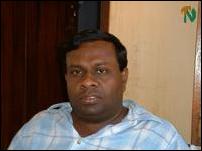 |
| Rev. Immanuel Ravichandran
|
But since the time they came to resettle in their village, the coir makers of Uthayasooriyan Kiramam to whom the husks belong have been pleading in vain to retrieve their raw material from the garrisoned shore of the lagoon.
Coir is a stiff coarse fibre from the outer husk of a coconut, highly resistant to salt water used in the manufacture of ropes, mats, baskets, brushes, and brooms.
The word ‘coir’ is derived from ‘Kayiru,’ Tamil for rope.
The Uthayasooriyan Kiramam is a settlement in the Periyamavadi village by the lagoon coast southeast of Chavakachcheri town. It was originally established mainly as a settlement for the Municipal workers of Chavakachcheri town.
“The husks were placed in the shallows before the fighting started in 2000. They do not rot in the brine. They would now be in the ideal condition to beat them into coir. Now we cannot get anywhere near the place where we placed the husks. The Sri Lanka Army is yet to consider our appeals,” one of the resettlers told TamilNet.
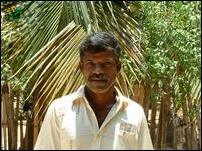 |
| Mr. Kasipillai Amirthaligam
|
“There was a coir factory in here before the army captured Jaffna from the Liberation Tigers. Many in the village were gainfully employed there. The SLA made it a camp when it moved into the area,” said Rev. Immanuel Ravichandran, the parish priest of St. Liquorys Church of Periyamavadi.
The raw material for coir was available in plenty from the extensive coconut plantations of Thenmaradchi; and the shallows by the lagoon coast were ideal for soaking and maturing the husks. Therefore coir making was a major industry in these parts before the SLA garrisoned this coast.
“Here you can see for yourself the reason why Jaffna’s once vibrant coir industry is almost dead now. The prices of rope and other coir-based products are high in Jaffna and these are brought from the southern parts of the island,” Rev. Ravichandran told TamilNet.
A long derelict coir machine is discernible on the shore behind the high security zone (HSZ) fence near Uthayasooriyan Kiramam.
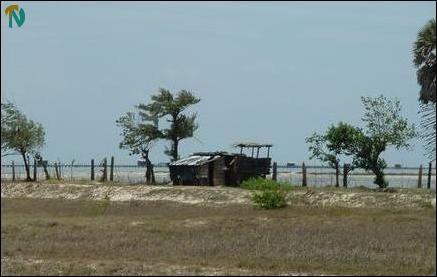 A section of the fenced off HSZ in Kachchai
A section of the fenced off HSZ in KachchaiThe lot of fishermen in the villages further east of Periyamavadi is no better than that of the coir makers.
“The army permits us to fish from 6 a.m. to 11 a.m. and then from 2 p.m. to 6 p.m. We can fish only within the area demarcated by the military – three kilometres in the lagoon from Kachchai jetty and a kilometre each on either side of it. We cannot use canoes or boats. Nor can we take food with us when we set out to sea,” says Mr. Kasipillai Amirthaligam, 45 secretary of Kachchai Fishermen’s Co-op Society.
“Fishermen who fail to obey these rules are punished indirectly. They would be subjected to deliberate delays in checking,” he said.
“The military’s HSZ is beyond the Kachchai junction. We have to surrender the special identity cards issued to us by the army at the junction checkpoint and obtain a token from the soldiers there when we go to the beach. Then we have to show the token at the sentry guarding the entrance to the coast HSZ,” Mr. Amirthalingam told TamilNet.
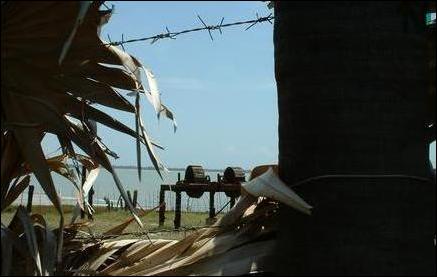 A derelict coir machine on the Periyamavadi shore HSZ
A derelict coir machine on the Periyamavadi shore HSZFishermen here say that the SLA's ban on using canoes and boats in the lagoon will affect them seriously once the monsoon showers arrive.
“We won’t be able to wade and fish when the water level rises during the monsoon. We have to get permission from the army early to use canoes for fishing,” said Mr. Ponnaiah Balasingham, 55.
Fishermen in these parts catch prawns, crabs and small fish, which they themselves market in the towns of Chavakachcheri (9 km) and Kodikamam (3 km).
There were more than 50 canoes in Kachchai in the past. Only 6 remain today. Some were lost during the war. But many were sold by fishermen to survive destitution during the days of displacement.
“No aid organisation has visited us so far. Few people in the world outside have heard of our plight,” a resident of Ketpali lamented.
Fishermen in Kachchai said that Mr. T. Maheswaran, Minister for Hindu Affairs, had come to the area earlier this year but that he was not allowed to see the beach in the army’s HSZ.
The SLA, meanwhile, is building a causeway to Salambamtheevu, two kilometres from Kachchai through the lagoon, using tens of thousands of Palmyra logs. Although part of it lies in the demarcated area in the lagoon, fishermen are not allowed to get near the log bridge, which is now being extended to Aruguweli further up the coast. Thousands of Palmyra palms in the HSZs south and southwest Chavakachcheri have been cut down for logs to pack the causeway with.
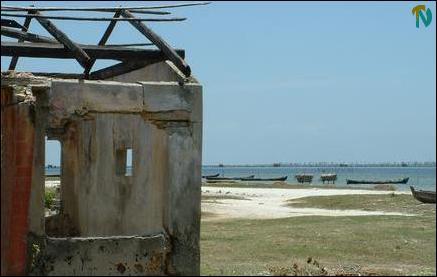 The bombed out shell of the Koilakandy community centre
The bombed out shell of the Koilakandy community centreHundreds of families from villages along this coast fled heavy fighting between the Liberation Tigers and the Sri Lanka army in 2000. Some returned after the ceasefire last year and were allowed to resettle under draconian conditions of the garrisoned coast.
Ninety families resettled in Kachchai with the military’s permission following the ceasefire last year. One hundred and ten persons from these families are engaged in fishing now. Fifty families have resettled in Ketpali East. Fishermen here cannot fish beyond Koddukkinaru Sri Lanka Navy base further east by Kilaly.
There are about 250 acres of paddy along this coast inside the HSZs in Palavi, Kachchaithurai south, Ketpali and Pungadipillaiyar.
One hundred and ten fishermen from Allarai, Uppukerni and Meesalai in the interior, east of Chavakachcheri, depend on the coast along Periyamavadi and Thambuthottam for their livelihood. But the SLA has granted passes only to seventy fishermen to enter the HSZ here.
However, Lt. Col. Dias of the 52-1 brigade has told their representatives that passes for fishing were restricted because live round fired by troops during training at the SLA base in Thambuthottam might hit fishermen wading close to the shore.
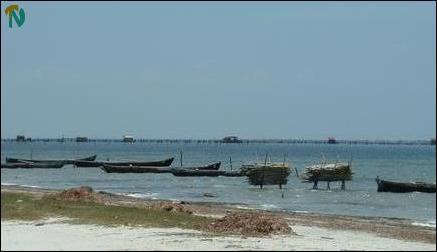 The palmyra log bridge as seen from the Koilakandy coast
The palmyra log bridge as seen from the Koilakandy coastThe SLA does not allow fishermen access to the lagoon through Periyamavadi. Instead, they have to cycle with all their gear for about six kilometres to enter the beach at Pungadi Pillaiyar Kovil in Kachchai.
One hundred and seventy families have resettled in Koilakandy, the main fishing village on this coast. Two hundred and ten persons are engaged in fishing here. The village is about 12 km from the A9 Road between Chavakachcheri and Jaffna town. The sand road to the village winds through the SLA’s vast high security zone south of the A9 inside which thousands of paddy fields lie fallow.
Koilakandy fishermen are permitted to fish in area in the lagoon demarcated by the SLA, which is five km long and 2 km wide.
The military has built a fence in the lagoon from Thanangkilappu coast to Ariyalai East to block fishermen from going beyond the demarcated area.












